Nearly everyone wants to live a long and healthy life. That's why the market for anti-aging therapies is in the tens of billions of dollars, and there's been a great shift to focusing on healthspan -- the number of healthy years one lives.
So what's the key to aging slower? According to a growing body of research, the answer is simple and perhaps obvious: bodily aging is a function of cellular aging. If we want our bodies to stay young, we need our cells to stay young, too.
An Introduction to Fisetin, Powered by ProFisetin
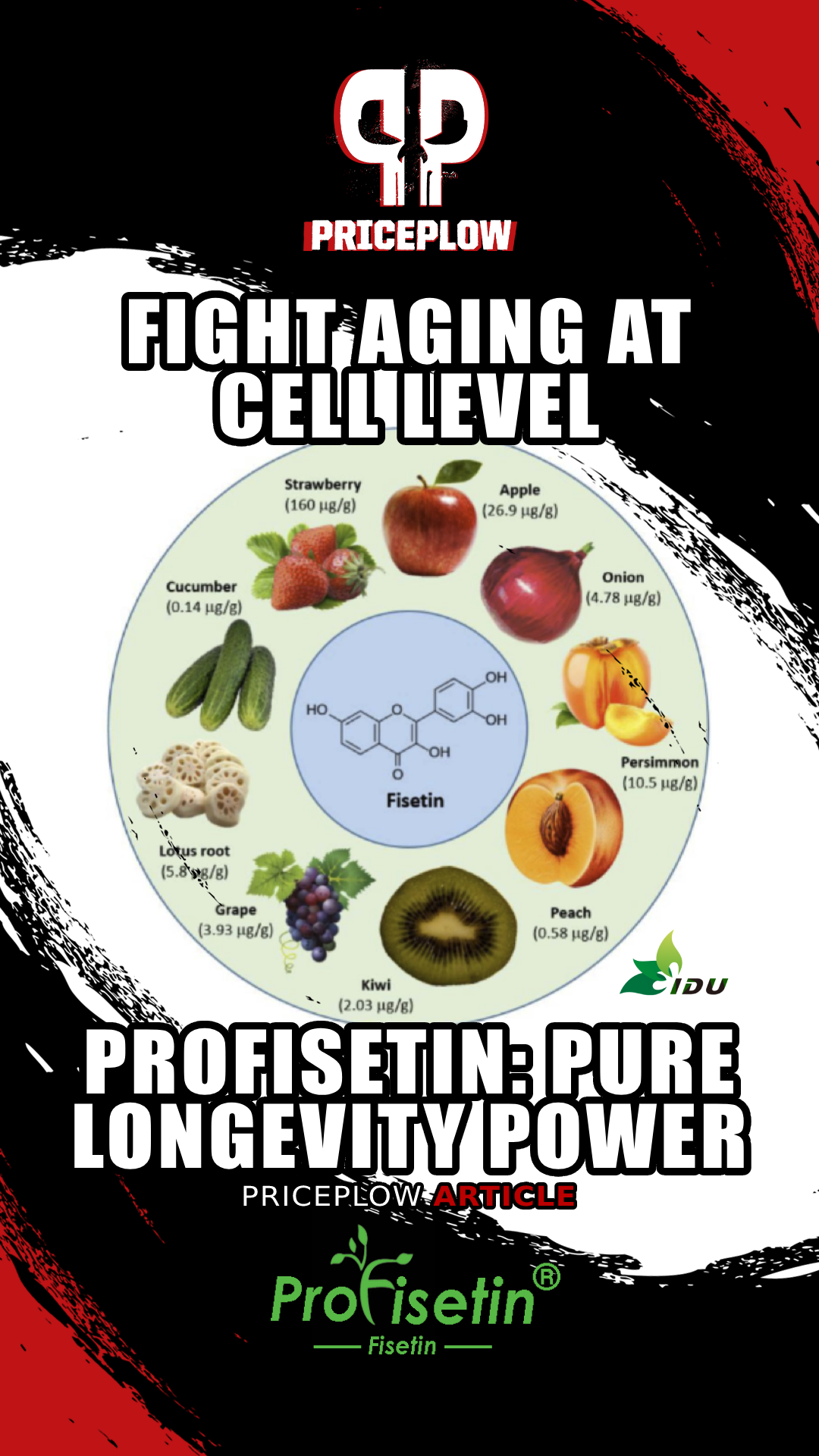
Nature's most powerful senolytic gets an upgrade! Aidu Biotech's ProFisetin offers 85-98% pure fisetin from Smoke Tree extract. Research shows it outperforms other polyphenols at clearing senescent cells and supporting healthy aging. Available in multiple standardizations!
This article is about fisetin, a natural flavonoid found in various fruits and vegetables, such as strawberries, apples, and onions. While it may seem unassuming, this plant compound is gaining attention for its impressive potential in the anti-aging space. In recent years, scientific research has begun to uncover how fisetin may benefit overall health, particularly by reducing inflammation and oxidative stress, two key factors in the aging process.
As we age, our cells accumulate damage from environmental factors and normal metabolic activity. Fisetin has shown tremendous promise in combating this damage, potentially slowing cellular aging.
One primary reason fisetin has become popular is its ability to act as a "senolytic" agent: It helps clear out senescent cells, which are damaged cells that build up over time and contribute to age-related decline. This makes fisetin a unique and exciting ingredient in the world of longevity supplements. Senolytics are compounds that target and help remove harmful senescent cells, potentially improving health and extending lifespan, as seen in animal studies.
But fisetin's benefits don't stop there; it's also being researched for its positive effects on brain health, inflammation, and overall vitality.
In this article, we'll explore how fisetin works, why it's important for healthy aging, and the exciting advancements around ProFisetin from Aidu Biotech, the sponsor of this article who's graciously agreed to show their lab tests in this article. You can sign up for PricePlow's Aidu Biotech and fisetin news alerts, and then we get into the science behind this ingredient.
Below is a background on aging and senescent cells, followed by our deep-dive into fisetin itself. After that, we explain the great work Aidu Biotech's doing with ProFisetin, with lab tests, standardization options, and some anti-aging supplement stack/formulation ideas. Before we get in, be sure to sign up for PricePlow's alerts so you stay up to date with the latest news and research:
Subscribe to PricePlow's Newsletter and Alerts on These Topics
Aging and the Introduction of Senescent Cells
Life on this planet is stressful, especially for our cells. Over the years, our cells take a heavy beating from repeated exposure to environmental stressors, leading to DNA damage, oxidative stress, and telomere shortening. Eventually, these damaged cells enter a state of permanently arrested growth called senescence.[1] Senescent cells can cause numerous problems for the entire organism, as they secrete pro-inflammatory compounds collectively known as the senescence-associated secretory phenotype (SASP), which contribute to chronic inflammation and interfere with tissue function.
In young, healthy organisms, the immune system efficiently clears away senescent cells, preventing major damage. However, as we age, two things happen:
- Cells become senescent faster, and
- Our immune system weakens.
Both factors lead to the inevitable accumulation of senescent cells.
There's a lot that can go wrong with human cells, which is why they have a failsafe mechanism called apoptosis, a process of programmed cell death designed to activate whenever cellular pathology threatens the body';s health. Unfortunately, senescent cells are resistant to apoptosis due to mechanisms known as the senescent-cell anti-apoptotic pathways (SCAPs).
Senolytic Agents: Compounds That Improve Senescent Cell Elimination
Enter senolytic agents. These compounds selectively target and eliminate senescent cells from the body. Once removed, senescent cells pose no further risk of inflicting SASP-mediated damage. This article focuses on a senolytic agent named fisetin, sold as ProFisetin by the Aidu Biotechnology Company. Before diving into that, let's explain how this class of compounds works.
Generally, senolytic agents work by disrupting SCAPs, rendering senescent cells vulnerable to destruction by apoptosis. This is a selective mechanism—it destroys senescent cells while leaving healthy, functional cells intact.
Significant research funding has been directed toward finding senolytic agents, yielding compelling findings. For instance, some animal studies identified dasatinib, a chemotherapy drug, and quercetin, a flavonoid, as a potent senolytic combination. However, this treatment, referred to in the literature as D+Q, has notable issues, including a high potential for toxicity. Dasatinib administration has been linked to low white blood cell count, low platelet count, and gastrointestinal issues.[2]
Additionally, dasatinib's status as a prescription drug makes it relatively inaccessible outside clinical settings. To maximize impact at the population level, researchers sought safe, natural, and accessible senolytic agents.
And after a tremendous amount of research, we may have found the best one that nature has to offer:
Fisetin: Elite Slayer of Senescent Cells
Fisetin, a naturally-occurring flavonoid, fits the bill. It emerged victorious from a 2018 study that assessed various polyphenols for senolytic activity. This was no small feat, considering most of the tested compounds have an excellent reputation: the list included nutraceutical heavy-hitters like resveratrol, epigallocatechin gallate (EGCG), curcumin, apigenin, catechin, and quercetin.[2]
In the study, the strength of the senolytic compounds was evaluated through a screening process that involved applying them to two types of cells in vitro: murine embryonic fibroblasts (MEFs) and human fibroblasts, which had been made senescent through genotoxic and oxidative stress, respectively.[2]
How fisetin outperforms the anti-aging competition
The researchers used senescence-associated β-galactosidase (SA-β-gal) as the biomarker for senescence. This works because SA-β-gal is associated with lysosomal expansion, an increase in both the size and number of lysosomes, the organelles responsible for handling cellular waste. As cells enter senescence, damaged cellular components become more numerous and must be managed by an increasing number of larger lysosomes.[3] In other words, lysosomal expansion helps senescent cells maintain their capacity for autophagy, the mechanism of cellular self-renewal, in the face of increased cellular damage and dysfunction.
Compared to all other senolytic agents examined in the study, fisetin was the best at reducing the number of SA-β-gal positive cells.[2]
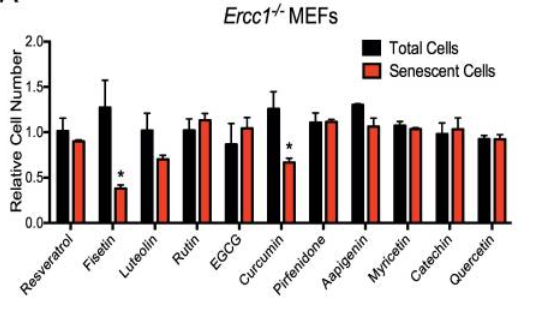
Treatment of a cell culture with fisetin (3,7,3′,4′-tetrahydroxyflavone) drastically reduced the number of senescent cells, far more than any other compound tested.[2]
Once fisetin was established as the most potent senolytic agent under examination, it was used as the active intervention in a placebo-controlled in vivo experiment.[2]
The in vivo portion of the study included two experiments: the first involved mice genetically modified to be predisposed to accelerated aging, known as progeroid mice. The second experiment was conducted with wild-type mice, which are genetically normal.
Specifically, the progeroid mice were modified with a mutation in the excision repair cross-complementation group 1 (ERCC1) gene, which plays a key role in DNA repair. In Ercc1−/∆ mice, one allele of the ERCC1 gene is completely knocked out (−), while the other allele is partially functional (∆ or "delta"), meaning it has a deletion that reduces its normal activity. This mutation causes the mice to have defective DNA repair abilities, leading to the accelerated accumulation of DNA damage, which drives the aging process more quickly than in normal mice.[2]
As a result, Ercc1−/∆ mice exhibit many symptoms of accelerated aging, including osteoporosis, rapid neurodegeneration, and decreased lifespan. This makes them an excellent model for studying aging mechanisms and testing anti-aging therapies like fisetin.[2]
The Ercc1−/∆ mice also carried a p16^INK4a-luciferase reporter, enabling real-time tracking of senescent cells via bioluminescent imaging. This works by linking the luciferase gene to the p16^INK4a senescence marker, so when senescent cells accumulate, they express luciferase, a compound that emits light when exposed to luciferin via injection. This allowed researchers to non-invasively quantify senescent cell burden in the living animals.
The progeroid mice were fed a fisetin-enriched diet containing 500 ppm (~60 mg/kg/day) intermittently, with 2-week treatment intervals. A control group of mice was fed a standard diet without fisetin for comparison.
During the experiment, the fisetin-treated mice exhibited significantly less luciferin-induced bioluminescence than the controls, indicating a decrease in senescent cells. This reduction persisted even after treatment ceased, suggesting that fisetin works via a "hit-and-run" mechanism—clearing senescent cells permanently rather than requiring continuous administration.[2]
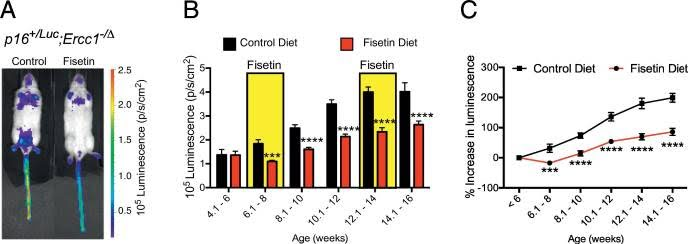
a) control vs. progeroid mouse bioluminescence at 12 weeks; b) lucerifase signal as measured biweekly during the progeroid experiment; c) % change in luciferase signal over time.[2]
After 10 weeks of treatment, tissues from the fat, liver, spleen, and kidney were collected and analyzed for senescence markers, including various SASP factors (e.g., IL-6, MCP-1). Fisetin significantly reduced these markers in all tissues compared to the control group.[2]
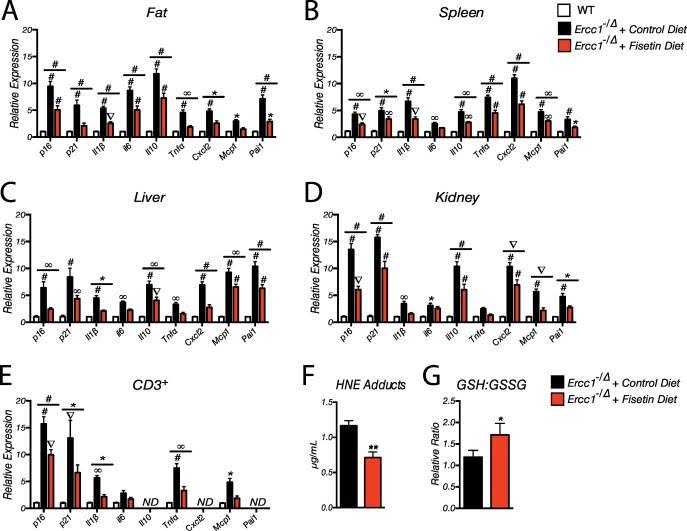
A) through D) exhibits the results of tissues from 20-week-old Ercc1−/∆ mice (fisetin-treated and control) analyzed for senescence (p16^Ink4a, p21) and SASP markers using qRT-PCR. E) Senescence and SASP markers were measured in CD3+ T cells by qRT-PCR. F) HNE adducts were measured in the liver to assess oxidative stress. G) GSH/GSSG levels were measured in the liver to evaluate antioxidant capacity. WT mice were used as a control for some comparisons.[2]
In short, the progeroid experiment demonstrated that fisetin is a potent senolytic that effectively clears senescent cells in vivo, improves tissue homeostasis, and reduces inflammation in progeroid mice.[2]
In the wild type experiment, wild type (WT) mice were given 100 mg/kg of fisetin daily for 5 consecutive days via oral gavage. The control group received no fisetin.[2]
72 hours after the final fisetin dose, tissue samples were collected from both groups of mice.[2]
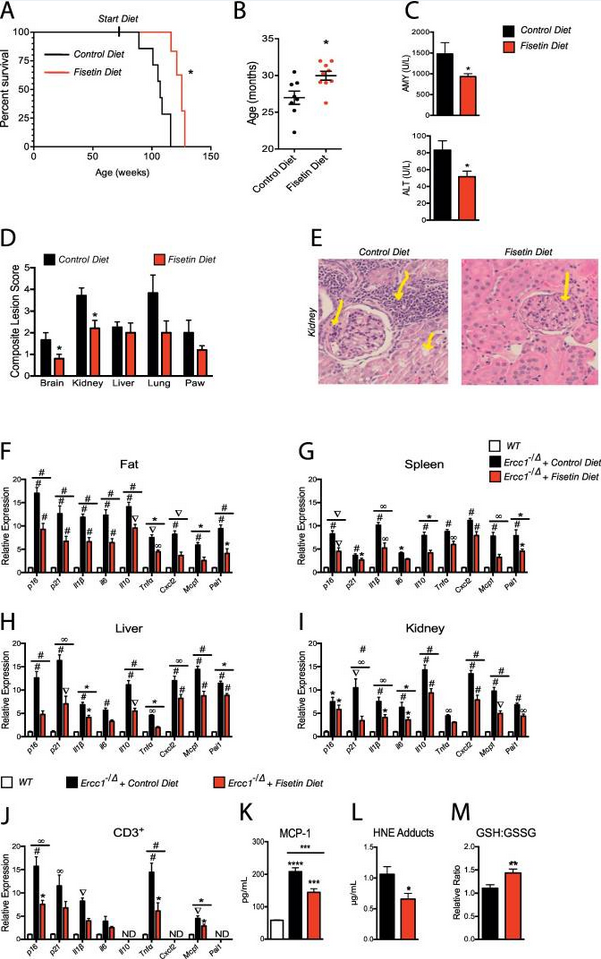
A) Lifespan was measured using the log-rank (Mantel-Cox) test with 8–9 mice per group. B) Median lifespan of WT mice was assessed. C) Blood clinical chemistry markers for liver (alanine aminotransferase/ALT) and pancreas (amylase/AMY) dysfunction were analyzed. D) Histopathological analysis was performed using the Geropathology Grading Platform. E) Kidney images showed healthier tissue in fisetin-treated mice compared to controls, with reduced cellularity and lymphoid aggregates. F-I) Tissues from mice over 120 weeks old were analyzed for senescence markers. J) Senescence and SASP markers were measured in CD3+ peripheral T cells. K) Levels of the SASP factor MCP-1 in the blood were measured by ELISA, with 5 mice per group. L) 4-hydroxynonenal (HNE) adducts, a marker of oxidative stress, were assessed. M) The ratio of reduced (GSH) to oxidized (GSSG) glutathione in the liver was determined.[2]
The big finding from this study is that fisetin treatment significantly increased the median lifespan of the WT mice, even though treatment started when the mice were relatively old (20 months old).[2] As shown in section B of the inset image summarizing the results of the WT mouse experiment, median lifespan increased by about 3 months, from 27 months to 30 months.[2]
That's obviously significant—a greater than 10% lifespan increase, which is a substantial effect size. All from a simple flavonoid polyphenol!
Using the geropathology grading platform, the researchers found that fisetin-treated mice showed significant improvements in tissue health across multiple organs, including the liver, kidneys, pancreas, and lungs. Compared to controls, the fisetin mice had fewer lesions associated with aging, such as cellular vacuolization and lymphoid aggregates in the kidneys.[2]
Fisetin significantly reduced the number of senescent cells, as measured by SA-β-gal activity, particularly in white adipose tissue (WAT). Spanning-tree Progression Analysis of Density-normalized Events (SPADE) showed that senescent immune cells, such as T cells, natural killer (NK) cells, and endothelial cells, were specifically targeted and cleared by fisetin.[2]
Fisetin also lowered levels of monocyte chemoattractant protein-1 (MCP-1), a marker of systemic inflammation and a component of the senescence-associated secretory phenotype (SASP), by a significant margin. This indicates reduced chronic inflammation and senescence-related secretory factors in the treated mice.[2]
Finally, fisetin was observed to significantly increase the WT mice's hepatic GSH/GSSG ratio (a measure of antioxidant capacity).[2] As regular readers of the PricePlow blog know, liver health is crucial for overall health, making this a very important result.
Other Research
The mouse study we just discussed is a thorough study, especially by preclinical standards, so it's a tough act to follow. However, there have been some other fisetin studies worth briefly discussing.
-
Antioxidant and α-Glucosidase Inhibitory Activities of Fisetin (2018)
This study assessed fisetin's antioxidant activity using several in vitro assays, including DPPH, ABTS, ORAC, and PSC.[4]
Antioxidant activity comparison between fisetin and BHA using DPPH (a) and ABTS (b) radical scavenging assays. Results demonstrate fisetin exhibits higher antioxidant capacity than BHA across all concentrations tested, indicating its potential as a powerful free radical scavenger.[4]
These assays are relatively obscure except for ORAC, which stands for oxygen radical absorbance capacity. If you have been in the health space for any length of time, you've probably seen foods and supplements ranked by their ORAC score.
The results demonstrated that fisetin has strong radical scavenging abilities, surpassing butylated hydroxyanisole (BHA), a synthetic antioxidant widely used in food preservation. In the DPPH assay, fisetin showed superior activity with a scavenging rate of 6.08 μg/mL compared to BHA's 10.42 μg/mL. Similarly, fisetin exhibited a higher ABTS scavenging activity at 24.77 μg/mL compared to BHA's 37.75 μg/mL. In the ORAC assay, fisetin effectively delayed the degradation of fluorescence caused by radicals, indicating its capacity to absorb oxygen radicals. The calculated ORAC value was 53,030.10 μmol trolox/g.[4]
To provide context for fisetin's ORAC number, the ORAC score for vitamin C (ascorbic acid), a well-known antioxidant, is approximately 1,000 to 2,000 μmol TE/g.[5] This indicates that fisetin is many times more potent in antioxidant capacity than vitamin C.
This study also tested fisetin's ability to inhibit α-glucosidase, an enzyme that breaks down carbohydrates into glucose. Using acarbose, a standard α-glucosidase inhibitor, as a reference, the study found that fisetin demonstrated a much stronger inhibitory effect. The IC₅₀ value of fisetin was 9.38 μg/mL, far superior to acarbose's IC₅₀ of 1.07 mg/mL. At a concentration of 15 μg/mL, fisetin achieved a 91.45% inhibition rate of α-glucosidase activity.[4]
This suggests that fisetin could support longevity by decreasing dietary carbohydrate absorption, thereby keeping blood glucose levels under control and maintaining long-term insulin sensitivity.
-
Fisetin inhibits inflammation and induces autophagy (2021)
In this study, researchers aimed to explore how fisetin modulates the inflammatory response and autophagy in macrophages stimulated by lipopolysaccharide (LPS), a component of Gram-negative bacteria that induces inflammation.[6]
Using high-throughput microarray analysis, the study identified 1,071 genes regulated by fisetin in LPS-treated cells. Many of these genes are implicated in immune function, underscoring fisetin's extensive immunomodulatory effect. The researchers focused on two key areas: fisetin's inhibition of inflammatory cytokine expression and its promotion of autophagy.
Fisetin significantly reduced the expression and secretion of several inflammatory cytokines, such as IL-1α, IL-1β, IL-6, and GM-CSF, confirmed by quantitative PCR and Bio-Plex assays. This anti-inflammatory effect was mediated through suppression of the PI3K/AKT/mTOR signaling pathway, which is typically activated by LPS, leading to inflammation and cytokine release. Fisetin inhibited the phosphorylation of key proteins in this pathway, thereby suppressing the inflammatory response.[6]
The study explored how fisetin influences autophagy, a process of cellular self-renewal that breaks down damaged proteins and organelles through the formation of autophagosomes. Researchers found that fisetin facilitated the fusion of autophagosomes with lysosomes, a crucial step in the degradation process blocked by LPS treatment. Markers such as LC3B and LAMP1, indicating autophagosome and lysosome activity, increased in LPS-treated cells but decreased after fisetin treatment. This effect was reversed by chloroquine (CQ), an autophagy inhibitor, suggesting that fisetin promotes autophagy by reversing the blockade in autophagosome-lysosome fusion caused by LPS.[6]
By promoting autophagy, fisetin can help resolve inflammation. Autophagy serves as a protective mechanism in the immune system, aiding in pathogen degradation, antigen presentation, and controlling the secretion of inflammatory cytokines. Thus, fisetin's inhibition of the PI3K/AKT/mTOR pathway not only reduces inflammation but also enhances autophagy, contributing to improved cellular function and reduced inflammatory damage.[6]
-
Preventing and Treating Neurological Disorders with the Flavonol Fisetin (2020)
This research review summarizes all significant pre-clinical (animal) studies on fisetin's neurological benefits to date.[7]
Effects of fisetin on spatial learning in Alzheimer's Disease (AD) mouse model using Morris Water Maze test. While untreated AD mice showed no improvement in platform location over 5 days, fisetin-treated AD mice demonstrated improved learning ability comparable to wild-type (WT) controls, suggesting fisetin's potential cognitive benefits in AD.[7]
Fisetin's anti-inflammatory, antioxidant, and apoptotic mechanisms have great potential significance in neurological diseases. The accumulation of senescent cells can affect the brain, so senolytic agents like fisetin should be beneficial here.
Fisetin has been studied in three types of Alzheimer's disease (AD) models: interventional (plaques injected directly into the brain), transgenic (genetically modified mice with AD-associated mutations), and sporadic (age-related) models. In all models, fisetin consistently prevented cognitive decline.[7] It reduced inflammation and oxidative stress markers, maintained synaptic protein levels, and increased memory and neurotrophic factor signaling. In a model of vascular dementia, fisetin also improved cognitive function and vascular health.[7]
Fisetin has also been tested in two models of Parkinson's disease (PD). The first is the MPTP model, where the neurotoxin MPTP induces PD-like symptoms in mice. The second is the rotenone model, which uses a pesticide to cause neuronal damage. In both models, fisetin increased dopamine levels and preserved tyrosine hydroxylase (TH) immunoreactivity, a marker of dopaminergic neuron health.[7] Fisetin also dose-dependently improved motor function and mitochondrial function while reducing oxidative stress.[7]
Fisetin was tested in the R6/2 mouse model of Huntington's disease (HD), a transgenic model with an aggressive disease course and shortened lifespan. In this model, fisetin improved motor function and extended lifespan by approximately 30%.[7]
The most commonly used preclinical model of amyotrophic lateral sclerosis (ALS) is the SOD1-G93A mouse model, which mimics familial ALS. In this model, oral administration of fisetin delayed the onset of motor deficits, slowed disease progression, and extended survival. Fisetin also increased motor neuron survival, as in the HD model, and activated the ERK pathway, which plays a role in cell survival and neuroprotection, similar to the AD models.[7]
Memory retention assessment in Morris Water Maze probe test comparing wild-type (WT) and Alzheimer's Disease (AD) mice with and without fisetin treatment. Fisetin-treated AD mice demonstrated improved memory function by spending more time in the target quadrant compared to untreated AD mice, approaching levels similar to WT controls.[7]
In the rabbit small clot embolism model (SCEM) of ischemic stroke, fisetin reduced stroke-induced behavioral deficits and increased the number of animals exhibiting normal behavior following a stroke. In a mouse model of temporary middle cerebral artery occlusion (tMCAO), fisetin reduced infarct size and inflammation when administered before or after ischemia. Fisetin also improved outcomes when combined with tissue plasminogen activator (tPA), the only FDA-approved treatment for stroke, especially when tPA was administered outside its optimal time window.[7] Additionally, fisetin was effective in models of hemorrhagic stroke, reducing brain edema, inflammation, and neuronal damage in both intracerebral hemorrhage (ICH) and subarachnoid hemorrhage (SAH).[7]
Fisetin was tested in a mouse model of traumatic brain injury (TBI), where it improved neurological function, reduced brain edema, and preserved the blood-brain barrier. These effects were linked to fisetin's antioxidant properties and its ability to modulate cell death pathways such as oxytosis and ferroptosis. Fisetin also increased levels of Nrf2, a transcription factor that regulates antioxidant defenses. Interestingly, fisetin remained effective in Nrf2 knockout mice, suggesting that it acts through multiple pathways to exert its neuroprotective effects.[7]
In addition to its effects in models of neurological disease, fisetin has been shown to improve memory and cognitive function in models of aging. In young adult mice, fisetin enhanced long-term memory (LTM) in an object recognition test and facilitated long-term potentiation (LTP) in hippocampal slices, a process thought to underlie memory formation. In aged rats, fisetin reduced markers of oxidative stress and neurodegeneration, while in aging mice, fisetin extended lifespan and improved indicators of brain health.[7]
ProFisetin from Aidu Biotechnology: A Superior, Natural Fisetin Extract
Aidu Biotech brings to the market ProFisetin®, a highly-tested and transparent ingredient that sets a new standard in fisetin supplements. Derived from the Cotinus coggygria plant (commonly known as the Smoke Tree), ProFisetin offers a potent and natural solution for brands and formulators seeking to incorporate fisetin into their wellness supplements. This plant has been used historically for its medicinal properties, and now, Aidu Biotech has refined its extracts to deliver high-purity fisetin in a convenient and bioavailable form.
-
ProFisetin: Multiple Standardization Options
ProFisetin is available in several purity grades—85%, 95%, and 98%—all rigorously tested using HPLC (High-Performance Liquid Chromatography) to ensure exceptional quality and consistency. It is also tested by independent third-party labs, confirming that every batch meets stringent specifications for purity, heavy metals, microbial contamination, and overall safety. This commitment to transparency and quality makes ProFisetin a top choice for consumers and formulators alike.
-
ProFisetin Lab Tests
Aidu Bio is allowing us to share some of these lab tests, which are shown below:
HPLC analysis by Certified Group demonstrates ProFisetin's potency, testing at 90.27% fisetin content - significantly above the 85% specification. Testing performed November 2024 using the ALC130A method at their ISO/IEC 17025:2017 accredited facility.
Heavy metals analysis by Eurofins shows ProFisetin meets strict safety standards. Testing reveals negligible levels of lead (<0.05 mg/kg), cadmium (<0.005 mg/kg), arsenic (0.00983 mg/kg), and mercury (0.00573 mg/kg), confirming the ingredient's purity and safety. Testing conducted January 2024 using ICP-MS methodology.
Microbial testing by Eurofins shows ProFisetin meets strict cleanliness standards. Testing confirms absence of harmful bacteria like Salmonella and E. coli, with minimal aerobic bacteria, yeast, and mold counts, demonstrating Aidu Biotech's commitment to product safety and quality control. Tests conducted December 2023 using FDA BAM methods.
Nutritional analysis by Eurofins confirms ProFisetin's purity, showing 97.12% carbohydrates with minimal fat (<0.1%), protein (<0.1%), and moisture (2.86%). Tests conducted July 2024 using standard AOAC testing methods demonstrate the extract's high purity and standardization as a concentrated fisetin source.
PAH analysis by Eurofins confirms ProFisetin's safety with minimal polycyclic aromatic hydrocarbons. Total PAH4 content measured just 1.2 μg/kg, with individual compounds like benzo(a)pyrene below detection limits, demonstrating the extract's purity. Testing conducted October-November 2024 using validated internal methods.
Aidu Biotech's ProFisetin combines these benefits with unmatched purity and a fully transparent production process, making it an optimal choice for those interested in anti-aging and metabolic health.
With storage facilities in both the USA and China, Aidu Biotech ensures rapid and efficient distribution, making ProFisetin accessible to formulators worldwide. Whether it's the 85%, 95%, or 98% assay, you can be confident in the purity and effectiveness of this powerful natural extract.
Stacking Ideas: How to Formulate Around Fisetin
ProFisetin works phenomenally on its own, but there's added potential in formulating it with complementary ingredients for even greater anti-aging and cognitive benefits. Here are some standout ingredients that can be stacked with ProFisetin for enhanced synergy:
- L-Ergothioneine: Known for its powerful antioxidant properties, L-Ergothioneine can work alongside ProFisetin to reduce oxidative stress and protect cells from damage. This makes it an excellent candidate for improving longevity and reducing inflammation.
- Niacin or NMN: Niacin (vitamin B3) and NMN (nicotinamide mononucleotide) are often used to boost NAD+ levels, essential for mitochondrial function and energy metabolism. Combining these with ProFisetin could further enhance its effects on cellular energy and anti-aging.
- Salidroside (Rhodiola extract): Salidroside is a potent adaptogen that has been shown to reduce stress and improve mental resilience. This is a great pairing with ProFisetin for individuals looking to balance cognitive performance with longevity benefits.
- Spermidine: Spermidine promotes autophagy, the cellular process that clears out damaged components, while fisetin acts as a senolytic agent that helps eliminate senescent cells. Together, they may complement each other in supporting cellular health and longevity by enhancing cellular cleanup mechanisms and reducing the accumulation of aged cells. Aidu Bio sells Supermidine, which is a natural 1% spermidine standardization from wheat germ extract
- Pterostilbene: This antioxidant compound activates sirtuin pathways, supporting healthy cellular function. When stacked with fisetin's senolytic action of eliminating senescent cells, the two compounds together may enhance overall cellular health and longevity by both promoting efficient cellular processes and reducing the accumulation of aged cells.
These combinations create an opportunity for brand formulators to offer consumers even more robust anti-aging, cognitive, and physical health benefits.
Conclusion: A Powerful Longevity and Metabolic Health Ingredient
The research on fisetin's ability to clear out senescent cells, reduce oxidative stress, and combat inflammation is compelling, positioning it as one of the most exciting anti-aging ingredients in recent years.
ProFisetin by Aidu Biotech is setting a new standard for the longevity and anti-aging supplement market. With its highly-purified forms (85%, 95%, and 98%) and extensive testing, it offers consumers and formulators a transparent, reliable source of this powerful senolytic. Combined with Aidu Biotech's commitment to transparency and quality, ProFisetin is a great choice for anyone looking to support healthy aging and metabolic health.
As research on fisetin continues to grow, its role in longevity and overall well-being will likely expand. Whether used as a stand-alone supplement or stacked with other synergistic ingredients, ProFisetin is shaping up to be a cornerstone in the future of anti-aging supplements.
Stay tuned for more research and innovation on fisetin and ProFisetin, and be sure to listen to PricePlow's upcoming video for the latest developments.


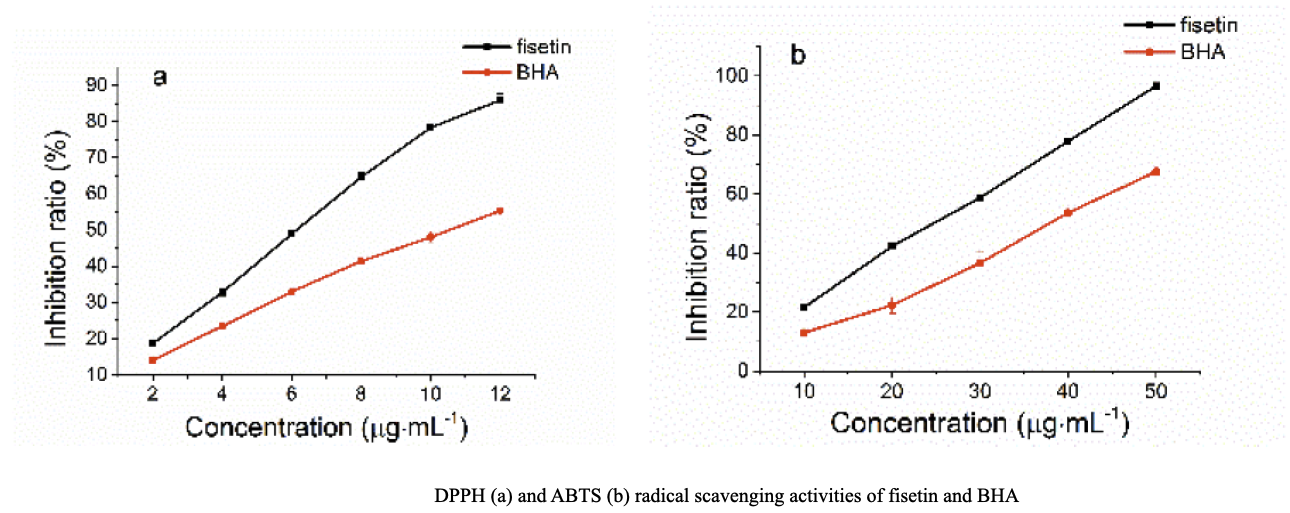
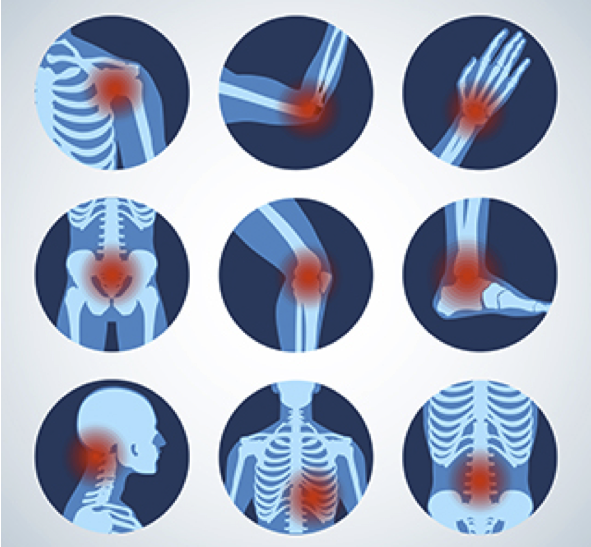
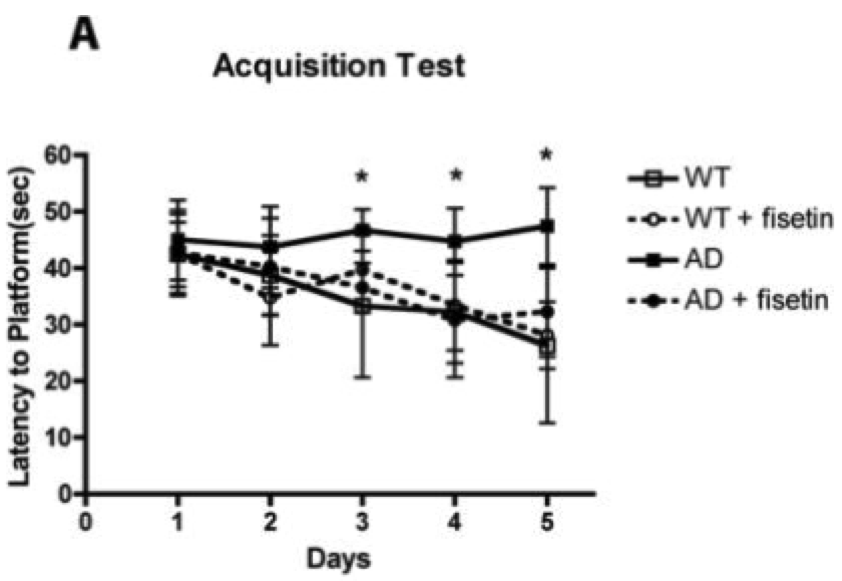
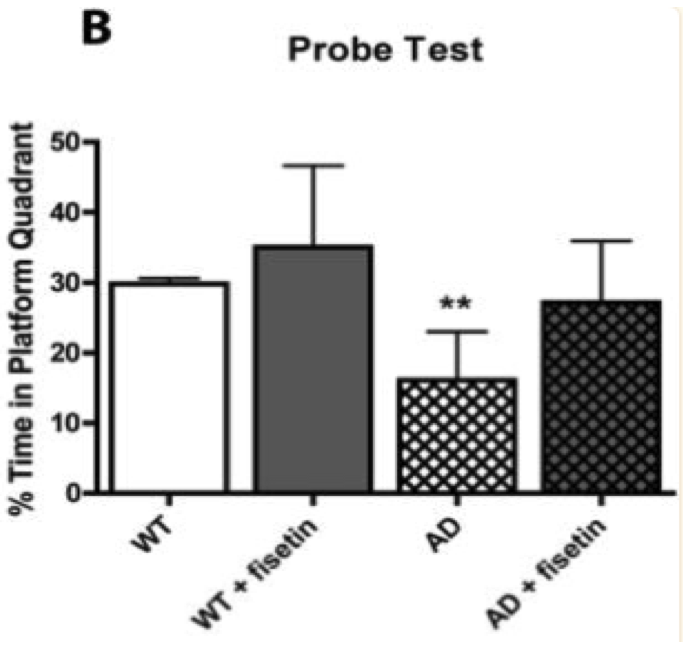
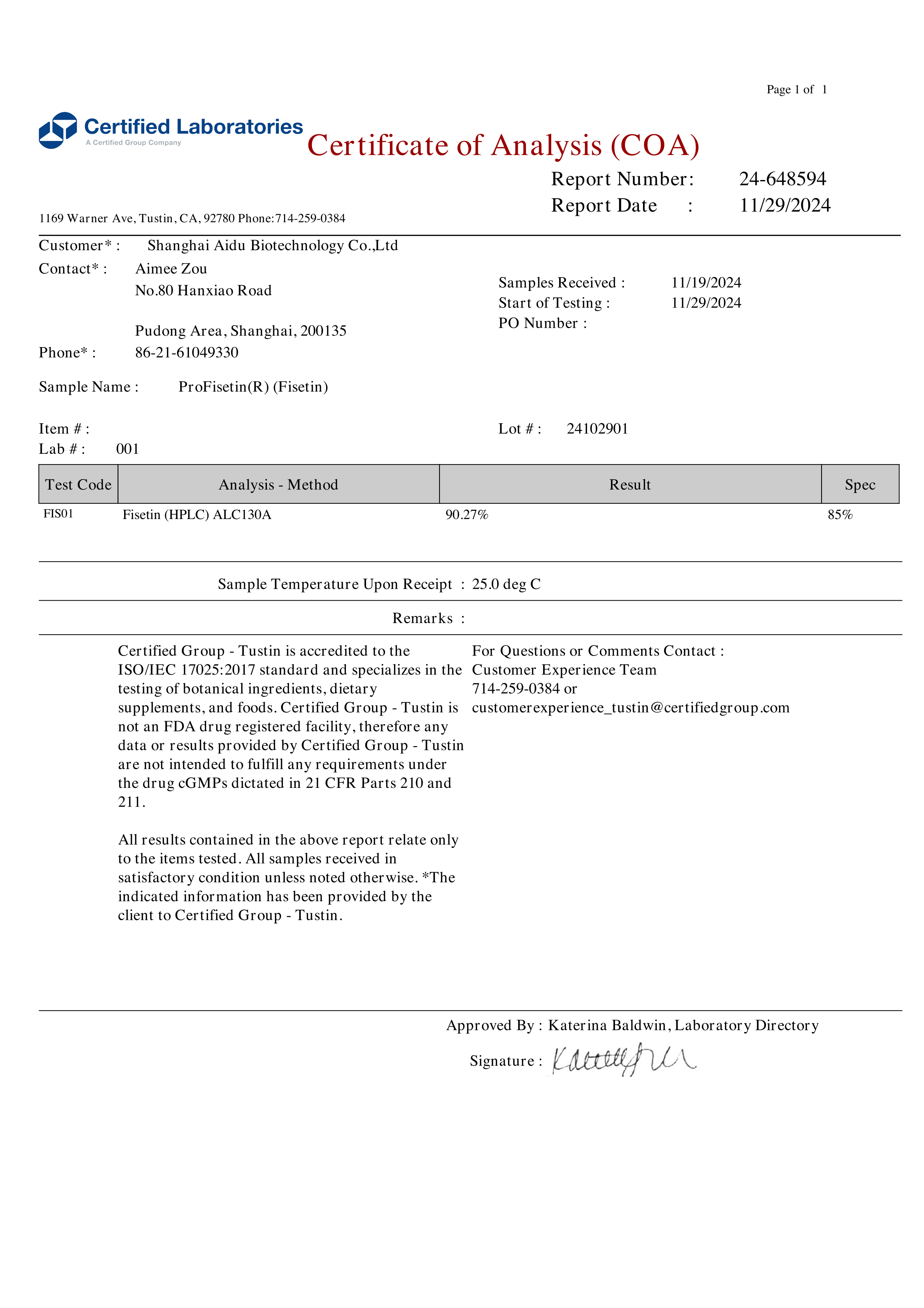
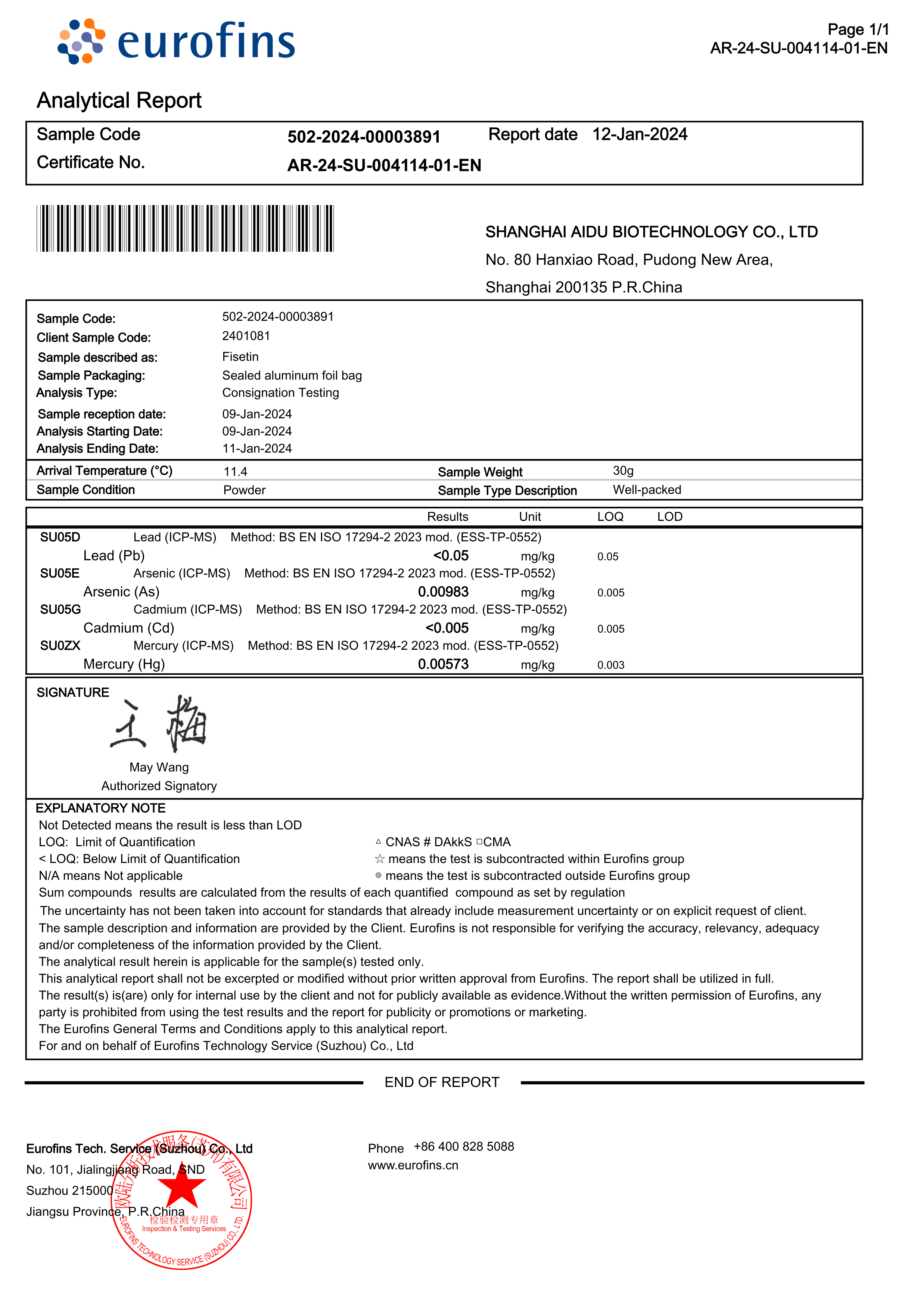
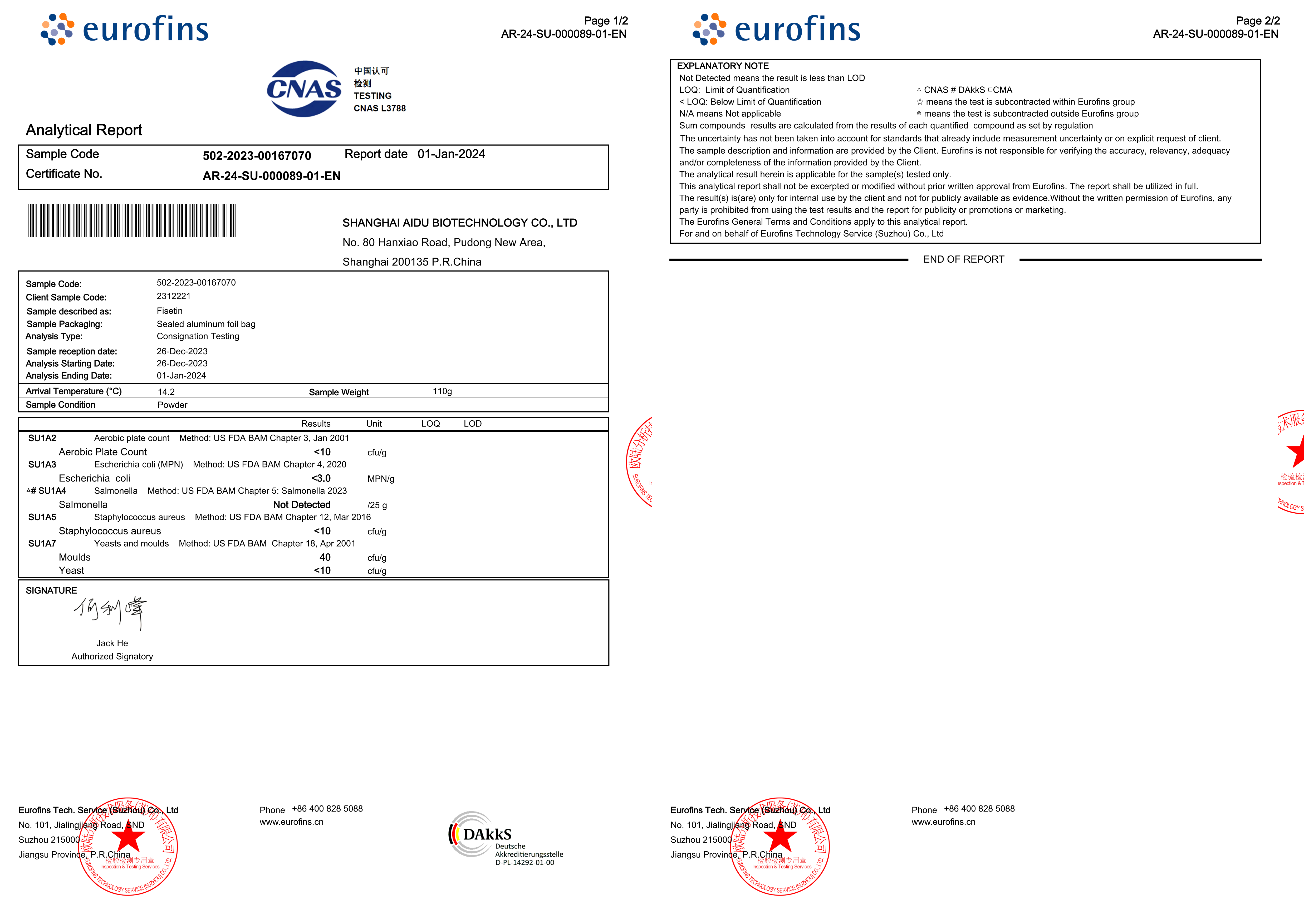
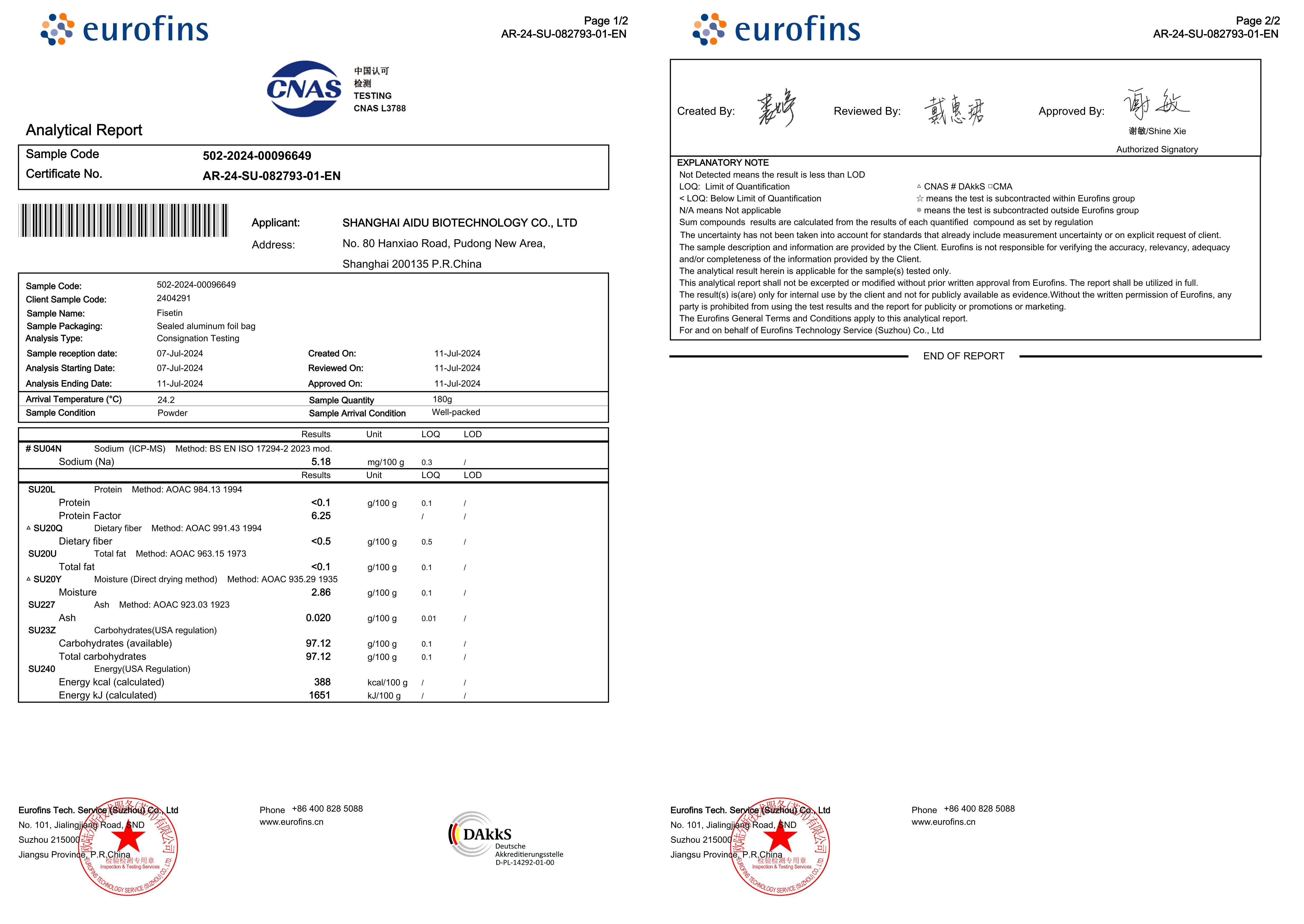
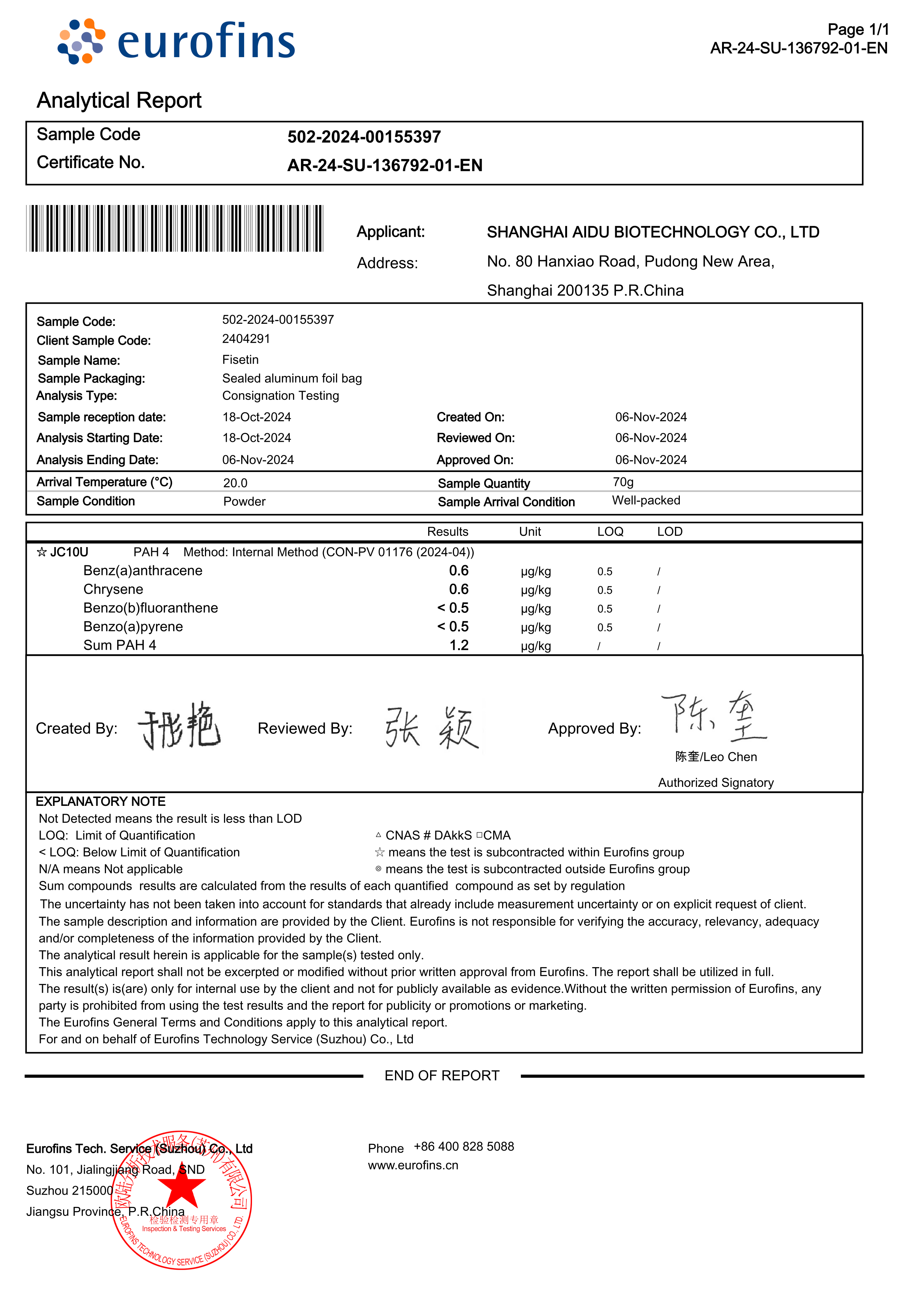
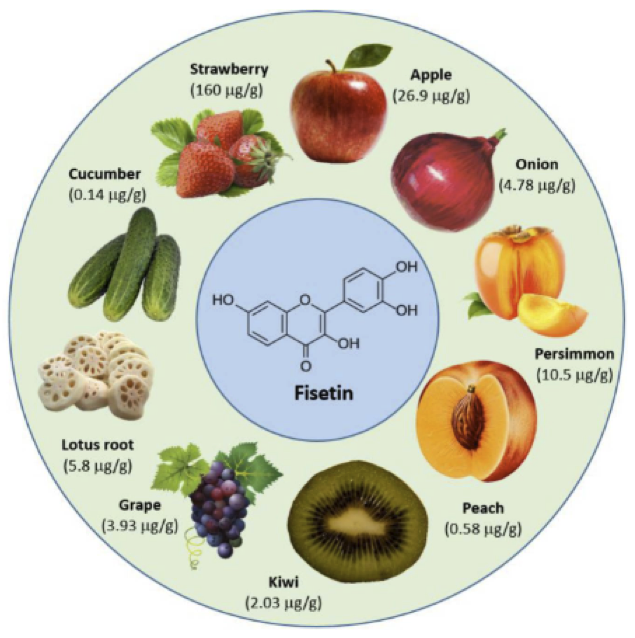



Comments and Discussion (Powered by the PricePlow Forum)